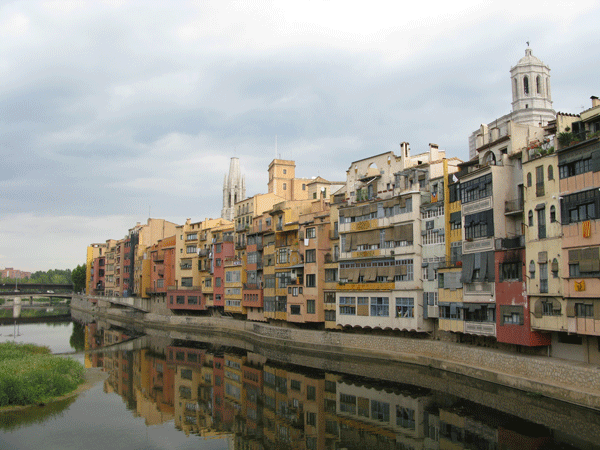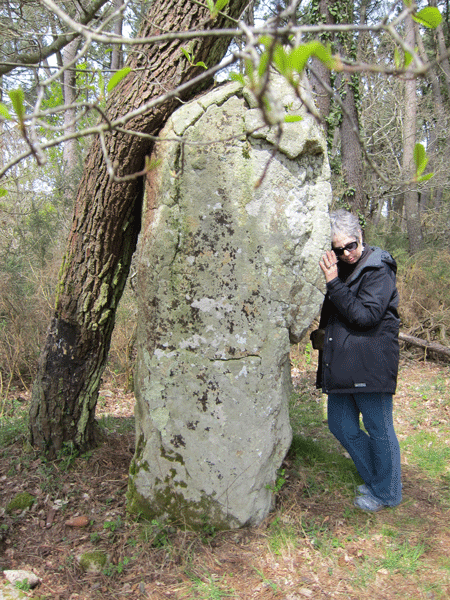Where in Girona Am I?
by Elyn Aviva
I am sitting in a chair on our fifth-floor terrace, looking out over the Onyar River to the hills and the Old Town of Girona. I can see tour groups starting to arrive. A queue of impatient visitors and uniformed school children is forming at the stone bridge, waiting for the shiny red “City Tour Train” to appear and transport them effortlessly through the winding streets.
It is the 60th Temps de Flors, the annual Girona flower festival held in early May. Tens of thousands of people jam the narrow cobblestone streets and stair-stepped alleys of the Old Town, admiring the profuse floral displays that adorn the private patios, gardens, and buildings normally closed to the public. The air is fragrant with flowers, their themes and textures as varied as the artists who design the installations.
Where am I? I am participating in the Temps de Flors—and I am honoring the dead. I, an ex-pat living in Girona, Catalonia, Spain, was inspired to create a series of 27 hand-felted vessels that I call “In Memoriam.” The series has been chosen to be part of this year’s Temps de Flors. I have used wool, water, and soap as my materials, not flowers.
Each vessel represents a medieval Jew who was buried in Montjuïc cemetery, which is located on a hillside just outside of town. Their broken gravestones, etched with partially illegible names and dates, are displayed in the Girona Museum of the History of the Jews. Some were found when a rail line was constructed at the bottom of the hill; others were re-used as building stones or as cattle troughs. They are a poignant reminder of the human desire to be remembered versus the ephemeral briefness of life.
Once, these people were part of the thriving Jewish community in Girona, one of the most important in Europe. The Call (Catalan for “Jewish quarter”) was a center for Kabbalah, the mystical branch of Judaism, and home to such important scholars as the 13th-century Rabbi Moses Nachmanides or “Ramban.”
But for over 500 years there has been no Jewish community here and no one to visit the graves. In 1492, all the Jews in Spain were forced to convert to Catholicism or be expelled, leaving their belongings, their homes—and their dead.
I made these 27 vessels to remember them. They suggest broken shells, silent screams, gravestones tipped on their sides. They are seedcases, husks, fragile yet protective, emptied of content but not of meaning.
The Kabbalah says that at Creation, all was perfect, but then the vessels were shattered. It is our task, through tikkun olam, to restore the vessels and heal the world.
I have learned that as long as the dead are remembered by the living, they are not forgotten.
Where am I? I am in Casa Cúndaro. I am sitting on a brown leather sofa next to the white display table that holds the 27 “In Memoriam” vessels. Casa Cúndaro is a carefully restored medieval Jewish building in the Old Town. It is now used for conferences and Kabbalist meetings, and part of it has been converted into tourist apartments. Normally it is not open to the public, but it is open during Temps de Flors. Different rooms have been decorated as they might have appeared in the Middle Ages—a market on the lowest level, a store-room filled with vegetables and herbs, a dining room with a loaf of braided bread and two candlesticks on a cloth-covered wooden table….
Visitors stream through, climbing the narrow stairs that unite one level to the next, one interconnected stone dwelling to another. Casa Cúndadro is built on a steep gradient, so you enter on one level and exit on another. During the centuries of increasing oppression, the Jews were forbidden to have windows or doors opening onto Christian streets, so houses were linked together to enable people to enter and exit the Call, and outside sometimes became inside. Oblong niches in several interior doorways in Casa Cúndaro recall the presence of mezuzahs, the small parchment prayer scrolls that were placed on the outside doorposts of Jewish homes. The mezuzah was a declaration of faith and also a symbol of God’s watching over the house and its dwellers.
The large walled garden has a six-foot-tall bronze menorah (candelabra) standing in one corner. Plants and flowers associated with the long-gone inhabitants fill the spacious patio, and the design around the fountain subtly suggests the shape of the Star of David.
Where am I? Or rather, When am I? I forget. Time slips back and forth in Casa Cúndaro. The old stones hold memories of laughing children, weeping mothers, studious fathers, of fear and delight and sadness, of joy—and despair. There is much despair.
Where am I? I am sitting in a room in Casa Cúndaro next to 27 felt vessels. They rest, topsy-turvy, on an undulating cream-colored cloth that resembles a burial shroud. I have placed several small stones amongst the vessels, stones I collected at Montjuïc cemetery. And I have sprinkled the shroud and the vessels with rust-red earth brought back from the Holy Land and given to me.
I am watching as people pass by. Some are drawn into this corner of the house by the multi-lingual posters describing the project, or perhaps by the mournful Sephardic music that accompanies the “In Memoriam” video. Photos of each engraved stone, the Spanish translation of the Hebrew inscription, and the associated felt vessel scroll by on the flat-screen monitor.
Young, old, husbands, wives, daughters, sons. Some of the funerary stones are so broken or disfigured that the carefully incised Hebrew inscriptions are no longer legible. I am confronted with the poignant contrast of enduring stone, the ephemeralness of life, and the fragility of memory—as fragile and ephemeral as flowers.
“Here lies the honorable N’Estelina, wife of the illustrious and respected En Bonastruc Josef… her abode is in the Garden of Eden….” “This funeral stele is …” “This stele commemorates the delightful and affectionate young Jacob, son of Jacob….” “Dark was the day, full of darkness and anguish…. Bitter tears are spilled…bitterly we weep….” “On the 17 of Ab in the year 5000 [in the Jewish calendar]….” “…his memory is a blessing…”
Some people glance into the room where I sit and then they walk on, exiting the building through the nearby door. Others draw close, reading aloud the wall-hung posters that explain the project. I hear many languages—Catalan, Spanish, French, English, Dutch, German. I listen to people explaining the vessels to each other. Some “get” it, others don’t. I watch a middle-aged woman’s lips move as she silently reads the list of the names on the 27 gravestones that are commemorated by these 27 felt vessels.
One woman starts to weep. A friend introduces her to me. She says, “The vessels are containers for their souls. I feel so sad.” Another person tells me, “I’m teary-eyed—and that’s not like me. After all, I’m British!” A young woman puts the impressive lens of her large camera up against the top of the display, recording individual vessels.
A couple confides, ““We live in Barcelona—but these are our ancestors.” I wonder: did their forebears flee in 1492 or were they forced to convert? They want their photo taken next to the display.
Where am I? I am sitting on that worn leather sofa, seeing people remember the dead. And who am I? Although my ancestors were Jewish, I wasn’t raised as a Jew. But perhaps—perhaps I am beginning to remember who I truly am.
Elyn Aviva is a transformational traveler, writer, and fiber artist who lives in Girona, Spain. Her blog is www.powerfulplaces.com/blog. She is co-author with her husband, Gary White, of “Powerful Places Guidebooks.” To learn more about her publications, go to www.powerfulplaces.com andwww.pilgrimsprocess.com. To learn about Elyn’s fiber art, go to www.fiberalchemy.com. Gary’s blog about their expat life is www.fandangolife.com.









